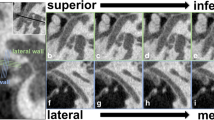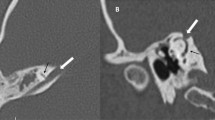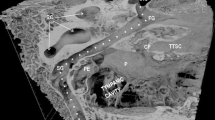Abstract
Introduction
The facial nerve is the most vulnerable structure during otological surgeries. Facial canal dehiscence (FCD) is the main risk factor for iatrogenic injuries. Its prevalence in clinical studies ranges between 6 and 33.3%, while anatomical studies report 25–57%. The objective was to determine the prevalence of FCD stratified by age and gender in a healthy population.
Materials and methods
Temporal bones from high-resolution computed tomography (CT) were analyzed. Patients with a history of trauma or tumors of the temporal bone, cholesteatomas, chronic middle ear disease, and any pathology that could modify the bone’s anatomy, were excluded.
Results
A total of 184 temporal bones were included. FCD was observed in 94 (51.2%) of the analyzed bones. The tympanic portion was the most frequently affected site with 91 (49.5%), followed by the mastoid segment with 3 (1.6%). No dehiscence was found in the labyrinth portion. We observed 30 (31.9%) of the FCD involved the oval window. Other bone defects identified with the FCD included: 11 (11.7%) with a lateral semicircular canal fistula and 7 (7.4%) with tegmen tympani erosions.
Conclusion
FCD has a high prevalence among healthy patients. A pre-surgical otological evaluation using high-resolution CT should be indicated to properly assess the patient and reduce the risk of injury.

Similar content being viewed by others
References
Yetiser S (2012) The dehiscent facial nerve canal. Int J Otolaryngol. 202:679708. https://doi.org/10.1155/2012/679708
Barnes G, Liang JN, Michaels L, Wright A, Hall S, Gleeson M (2001) Development of the fallopian canal in humans: a morphologic and radiologic study. Otol Neurotol 22(6):931–7. Available from: https://www.ncbi.nlm.nih.gov/pubmed/11698822
Linder T, Mulazimoglu S, El Hadi T, Darrouzet V, Ayache D, Somers T, Schmerber S, Vincent C, Mondain M, Lescanne E, Bonard D (2016) Iatrogenic facial nerve injuries during chronic otitis media surgery: a multicenter retrospective study. Clin Otolaryngol 42(3):521–527
Ryu N, Kim J (2016) How to avoid facial nerve injury in mastoidectomy? J Audiol Otol 20(2):68–72
Di Martino E, Sellhaus B, Haensel J, Schlegel JG, Westhofen M, Prescher A (2005) Fallopian canal dehiscences: a survey of clinical and anatomical findings. Eur Arch Oto-Rhino-Laryngol 262:120–126
Selesnick SH, Lynn-Macrae AG (2001) The incidence of facial nerve dehiscence at surgery for cholesteatoma. Otol Neurotol 22(2):129–32. Available from: https://www.ncbi.nlm.nih.gov/pubmed/11300257. Cited 8 Jul 2015
Moody MW, Lambert PR (2007) Incidence of dehiscence of the facial nerve in 416 cases of cholesteatoma. Otol Neurotol 28(3):400–4. Available from: https://www.ncbi.nlm.nih.gov/pubmed/17159491. Cited 8 Jul 2015
Daniels RL, Krieger LW, Lippy WH (2001) The other ear: findings and results in 1,800 bilateral stapedectomies. Otol Neurotol 22(5):603–7. Available from: https://www.ncbi.nlm.nih.gov/pubmed/11568665. Cited 8 Jul 2015
Li D, Cao Y (1996) Facial canal dehiscence: a report of 1465 stapes operations. Ann Otol Rhinol Laryngol 105(6):467–71. Available from: https://www.ncbi.nlm.nih.gov/pubmed/8638899. Cited 8 Jul 2015
Baxter A (1971) Dehiscence of the fallopian canal. An anatomical study. J Laryngol Otol 85(6):587–94. Available from: https://www.ncbi.nlm.nih.gov/pubmed/5581361. Cited 8 Jul 2015
Moreano EH, Paparella MM, Zelterman D, Goycoolea MV (1994) Prevalence of facial canal dehiscence and of persistent stapedial artery in the human middle ear: a report of 1000 temporal bones. Laryngoscope 104(3 Pt 1):309–20. Available from: https://www.ncbi.nlm.nih.gov/pubmed/8127188. Cited 8 Jul 2015
Weiglein AH, Anderhuber W, Jakse R, Einspieler R (1994) Imaging of the facial canal by means of multiplanar angulated 2-D-high-resolution CT-reconstruction. Surg Radiol Anat 16:423–427
Perez B, Campos ME, Rivero J, Campos DL, López-Aguado D (1997) Incidence of dehiscences in the fallopian canal. Int J Pediatr Otorhinolaryngol 40(97):51–60
Kim CW, Rho YS, Ahn HY, Oh SJ (2008) Facial canal dehiscence in the initial operation for chronic otitis media without cholesteatoma. Auris Nasus Larynx 35:353–356
Wiet RJ (1982) Iatrogenic facial paralysis. Otolaryngol Clin North Am 15(4):773–80. Available from: https://www.ncbi.nlm.nih.gov/pubmed/7162817. Cited 5 Jun 2015
Altuntas A, Unal A, Aslan A, Ozcan M, Kurkcuoglu S, Nalca Y (1998) Facial nerve paralysis in chronic suppurative otitis media: Ankara Numune Hospital experience. Auris Nasus Larynx 25(2):169–72. Available from: https://www.ncbi.nlm.nih.gov/pubmed/9673730. Cited 5 Jun 2015
Lin J-C, Ho K-Y, Kuo W-R, Wang L-F, Chai C-Y, Tsai S-M (2004) Incidence of dehiscence of the facial nerve at surgery for middle ear cholesteatoma. Otolaryngol Head Neck Surg 131(4):452–6. Available from: https://www.ncbi.nlm.nih.gov/pubmed/15467616. Cited 5 Jun 2015
Tüccar E, Tekdemir I, Aslan A, Elhan A, Deda H (2000) Radiological anatomy of the intratemporal course of facial nerve. Clin Anat 13(2):83–87. https://doi.org/10.1002/(SICI)1098-2353(2000)13:2%3c83:AID-CA2%3e3.0.CO;2-Y
Yildirim-Baylan M, Ozmen CA, Gun R, Yorgancilar E, Akkuş Z, Topcu I (2012) An evaluation of preoperative computed tomography on patients with chronic otitis media. Indian J Otolaryngol Head Neck Surg 64(March):67–70
Jaswal A, Jana AK, Sikder B, Sadhukhan SK, Jana U, Nandi TK (2008) Fallopian canal dehiscence: can it be pridicted. Indian J Otolaryngol Head Neck Surg 60(March):11–15
Ozbek C, Tuna E, Ciftci O, Yazkan O, Ozdem C (2009) Incidence of fallopian canal dehiscence at surgery for chronic otitis media. Eur Arch Oto-Rhino-Laryngol 266:357–362
Ocak E, Beton ÃS, Selcuk à (2016) Does dehiscence of the facial nerve canal affect. J Craniofac Surg 27(4):e374–e376. https://doi.org/10.1097/SCS.0000000000002635
Faramarzi M, Roosta S (2017) Incidence of facial nerve canal dehiscence in primary and revision cholesteatoma surgery. Indian J Otolaryngol Head Neck Surg 69(3):300–306. https://doi.org/10.1007/s12070-017-1094-5
Funding
No funding.
Author information
Authors and Affiliations
Corresponding author
Ethics declarations
Conflict of interest
All authors confirm there are no conflicts of interest.
Additional information
Publisher's Note
Springer Nature remains neutral with regard to jurisdictional claims in published maps and institutional affiliations.
Rights and permissions
About this article
Cite this article
Hernandez-Trejo, A.F., Cuellar-Calderon, K.P., Treviño-Gonzalez, J.L. et al. Prevalence of facial canal dehiscence and other bone defects by computed tomography. Eur Arch Otorhinolaryngol 277, 2681–2686 (2020). https://doi.org/10.1007/s00405-020-06013-8
Received:
Accepted:
Published:
Issue Date:
DOI: https://doi.org/10.1007/s00405-020-06013-8




